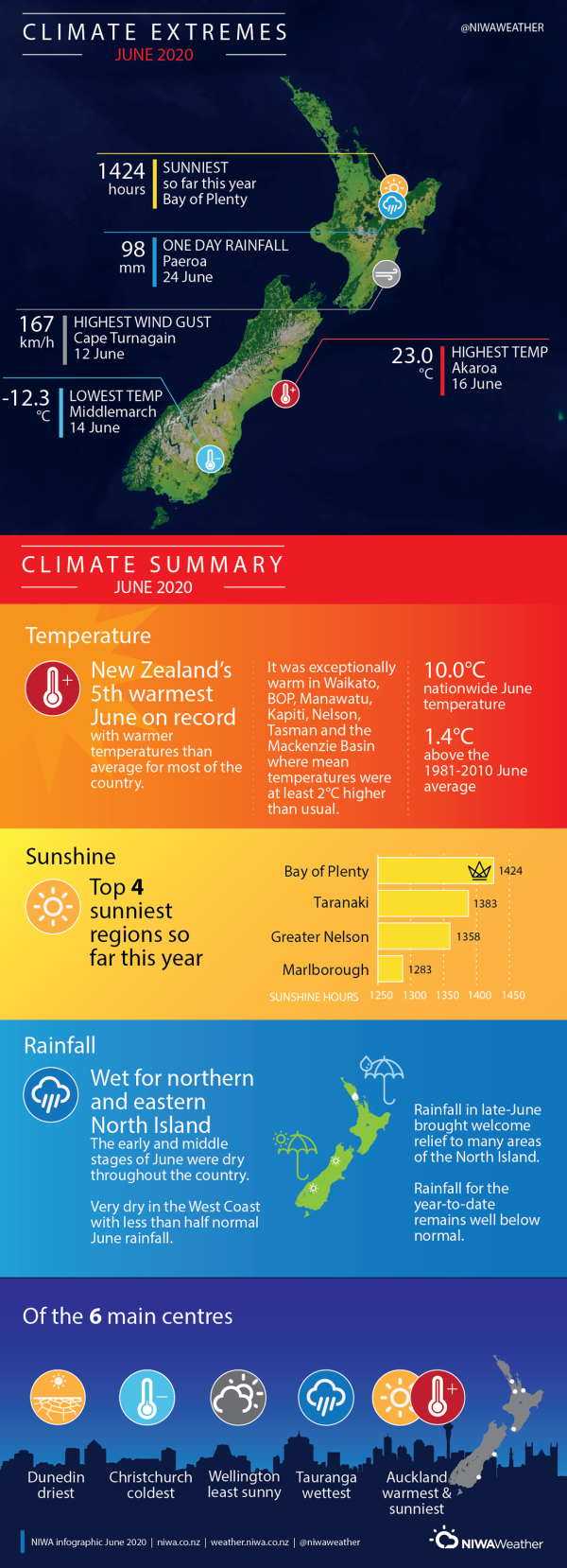Warm start to winter for much of the country
|
Temperature |
It was New Zealand’s fifth-warmest June on record. Temperatures were above average (0.51-1.20°C above average) or well above average (>1.20°C above average) throughout the North Island, as well as northern, central and western parts of the South Island. Temperatures were typically near average (±0.50°C of average) for the remainder of the South Island. |
|
Rainfall |
Rainfall was above normal (120-149% of normal) or well above normal (>149% of normal) for parts of Northland, Auckland, Bay of Plenty, Gisborne, Hawke’s Bay, western Taranaki, Wellington, eastern Canterbury, and inland parts of Otago. Rainfall was below normal (50-79% of normal) or well below normal (<50% of normal) for southern, western and northwestern parts of the South Island, inland parts of Manawatu and Whanganui, and western parts of Waikato. |
|
Soil Moisture |
At the end of the month, soil moisture levels were lower than normal for eastern and inland parts of Otago, south Canterbury, and inland parts of Manawatu and Whanganui. Near normal soil moisture levels were typical for the remainder of the country. |
Overview
June 2020 mean sea level air pressure was above normal in the southwest Pacific region, including over New Zealand. This was associated with more northeasterly air flows than usual over New Zealand. The pattern was La Niña-like in nature, in response to cooling ocean temperatures in the east-central equatorial Pacific. The prevalence of northeasterly winds meant it was a warm start to winter for many parts of the country. Temperatures were above average (0.51-1.20°C above average) or well above average (>1.20°C above average) throughout the North Island, as well as in Nelson, Tasman, West Coast, northern Marlborough, most of Canterbury and western Southland. Temperatures were typically near average (±0.50°C of average) for inland, eastern and southern parts of Otago and Southland. Overall, the nationwide average temperature in June 2020 was 10.0°C. This was 1.4°C above the 1981-2010 June average, making it New Zealand’s fifth-warmest June since NIWA’s seven station temperature series began in 1909.
There were considerable spatial differences in monthly rainfall totals observed over the country in June. The heaviest rainfall events were associated with a subtropical low pressure system delivering rain from an easterly-quarter wind direction. In the North Island, rainfall was above normal (120-149% of normal) or well above normal (>149% of normal) for parts of Northland, Auckland, Bay of Plenty, Gisborne, Hawke’s Bay, western Taranaki, the Kapiti Coast and Wellington. In contrast, rainfall was below normal (50-79% of normal) for inland parts of Manawatu and Whanganui, and western Waikato. For the South Island, rainfall was above normal or well above normal for eastern parts of Canterbury and inland parts of Otago. It was a dry month for Nelson, Tasman, West Coast, coastal Southland, as well as northern and southern parts of Otago, where rainfall was below normal (50-79% of normal) or well below normal (<50% of normal). By the end of June, soils were drier than normal in eastern and inland parts of Otago, south Canterbury, and inland parts of Manawatu and Whanganui. Soil moisture levels were typically near normal for remaining parts of the country.
Further Highlights:
- The highest temperature was 23.0°C, observed at Akaroa on 16 June.
- The lowest temperature was -12.3°C, observed at Middlemarch on 14 June.
- The highest 1-day rainfall was 98 mm, recorded at Paeroa on 24 June.
- The highest wind gust was 167 km/h, observed at Cape Turnagain on 12 June.
- Of the six main centres in June 2020, Auckland was the warmest and sunniest, Tauranga was the wettest, Christchurch was the coldest, Dunedin was the driest and Wellington was the least sunny.
- Of the available, regularly reporting sunshine observation sites, the sunniest four locations in 2020 so far are Bay of Plenty (1424 hours), Taranaki (1383 hours), Greater Nelson (1358 hours) and Marlborough (1283 hours).


